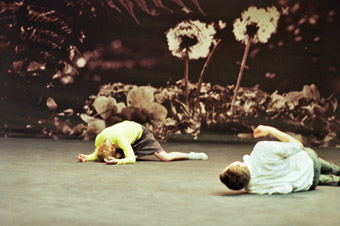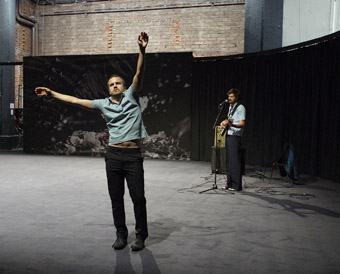 |
Maybe Forever, Meg Stuart, Philipp Gehmacher photo Chris van der Burght |
A huge image of two dandelions blown in the wind is stretched wide in front of the curtains, echoing the sense of romantic longing that tends to linger in such an environment. Two figures are positioned centre-stage, sitting side by side on the carpeted floor with legs stretched out and backs to the audience. Slowly they recline in unison until lying submerged in their world. As the man apprehensively stretches his arm out to take the woman’s, their intimate interplay begins.
Awkward engagement and disengagement in Meg Stuart and Philipp Gehmacher's Maybe Forever is at the core of this restless folding and unfolding duet. In every-day clothing they roll and struggle across the floor and stop for long periods, finding it difficult to make prolonged physical contact. The choreography has been given all the time and space it needs, allowing the work’s message to gradually and undetectably seep into the hearts of its audience like love-sickness. Penetrating insight into the nature of a steady declining relationship is delivered through the movement’s calculated clumsiness, which in its disregard of conventional dance codes provides an astonishing unpredictability.
Europe-based choreographers Meg Stuart and Philipp Gehmacher came together in 2007 to create Maybe Forever, which has been touring the world ever since and is performed as part of the main performance program of the 10th Indonesian Dance Festival in Jakarta. Although very different in their approaches to choreography, space and design, the two have arrived at a complementary meeting place that, unlike the disintegrating relationship they demonstrate, has proven to be a winning point of departure.
Stuart and Germacher are joined by Brussels-based singer-songwriter Niko Hafkenschield, whose shiny blue lounge jacket surreptitiously reinforces the tired pub-like environment. His sweetly melancholic series of indie-blues love ballads infuse the dancing with a fragile and delicate darkness. With his soft, vulnerable lilt he is a modern day angel of sadness—honest and open, almost unbearably so, in that his songs demand we be honest with ourselves.
 |
Maybe Forever, Philipp Gehmacher, Niko Hafkenscheid photo Eva Wordinger |
Gehmacher’s solo is performed in his signature style of timid apprehension, particularly in relationship to space. Shoulders inelegantly reaching for the ears and gawky transfers of weight as he walks from one position to the next create an uncoordinated language of movement that speaks volumes about his out-of-synch relationship with Stuart. It is almost as though he is embarrassed, self-conscious of the fact that there are people watching him. He pulls back the curtain and reveals part of the backstage area. Stuart enters and here they perform an 'almost hugging' phrase, manoeuvring around each other with difficulty, Gehmacher often failing to complete the touch. The cold black concrete of the theatre’s walls are exposed and so too is a cold and dying union.
The startling final act of the work plays out like a Lynchian memorial service, spooky enough to send shivers down my spine as I watch in disbelief. In a bright yellow shirt, black jacket and trousers, Gehmacher performs a final confession to the one he has lost about his failure to connect. He moves abstractly around centrestage and as he does so, a pre-recorded speech is laid over his performance, the text broken up, reversed and nonsensical. Without warning Stuart enters from the right in an intensely garish orange sequined dress, slinky and shimmering under the lights. We are caught off guard by this 'over-excited' outfit, which after the previous dowdy clothing makes an unsettling statement. Stuart takes a seat next to the musician’s speaker. He enters and stands behind her as if to claim her as his. Almost menacingly she simply sits and watches, looking ridiculously fabulous and no longer Gehmacher’s who is now out of his depth in this uncomfortable situation. And with a painstakingly slow lighting fade, this image is crystallized.
After seeing Maybe Forever I dreamt that I was having a conversation with the woman an ex-boyfriend of mine is seeing. She was crying hysterically, trying to make sense of their crumbling connection, demanding that I give her insight whilst simultaneously refusing to accept any advice I offered. For some reason this was all taking place on the sports field at my old primary school. This was an aptly surreal continuation of Stuart and Gehmacher’s performance which somehow managed to bleed further into my consciousness than I had hoped. Clearly, Maybe Forever affected me profoundly and like the memories of failed relationships will continue to stay with me, maybe forever.
10th Indonesian Dance Festival: Damaged Goods & Mumbling Fish, Maybe Forever, choreography & dance Meg Stuart, Philipp Gehmacher, live music: Niko Hafkenscheid, dramaturgy Miriam van Imschoot, lighting Jan Maertens, scenography, costumes Janina Audick, music, sound Vincent Malstaf; Graha Bhakti Budaya, Taman Ismail Marzuki, Jakarta, June 16
Cat Ruka is an emerging choreographer and performance artist from Auckland, New Zealand. She is currently developing her interest in dance criticism and is the editor of Yellingmouth, an Auckland-based dance review blog.
© Cat Ruka; for permission to reproduce apply to [email protected]








 back
back